What is the importance of EA skill assessment for engineers?
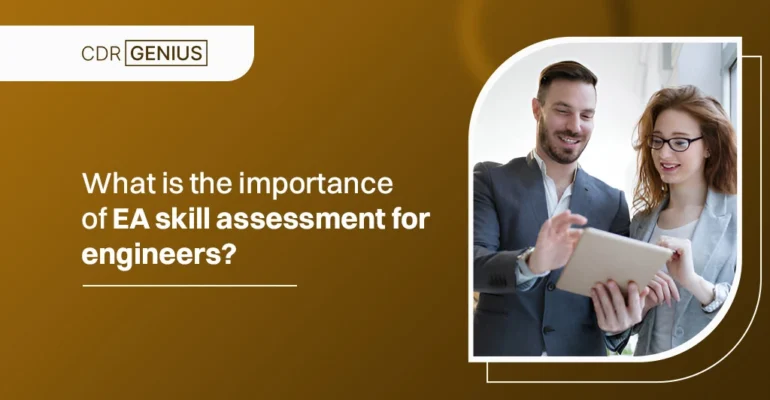
What is the importance of EA skill assessment for engineers?
In the competitive engineering world, especially in Australia, having your skills recognised and validated is crucial for career advancement. Engineers Australia (EA) is the designated authority for assessing the skills and qualifications of engineers who wish to migrate to Australia or gain professional recognition within the country.
The EA Skill Assessment is a process that ensures engineers meet the high standards required to practice in Australia and validates an engineer’s qualifications and experience but also opens doors to numerous opportunities in the Australian job market.
This blog will delve into the importance of EA Skill Assessment for engineers, the various pathways available, and why seeking expert advice can make a significant difference in your application.
Understanding EA Skill Assessment
The EA Skill Assessment is a formal evaluation conducted by Engineers Australia to determine whether an engineer’s qualifications and experience meet the standards required to practice in Australia.
This assessment is essential for engineers seeking to migrate to Australia, as it is often a prerequisite for obtaining a skilled migration visa. Successfully passing the assessment opens doors for professional opportunities and permanent residency pathways in Australia.
Why is the Engineers Australia Skill Assessment Important?
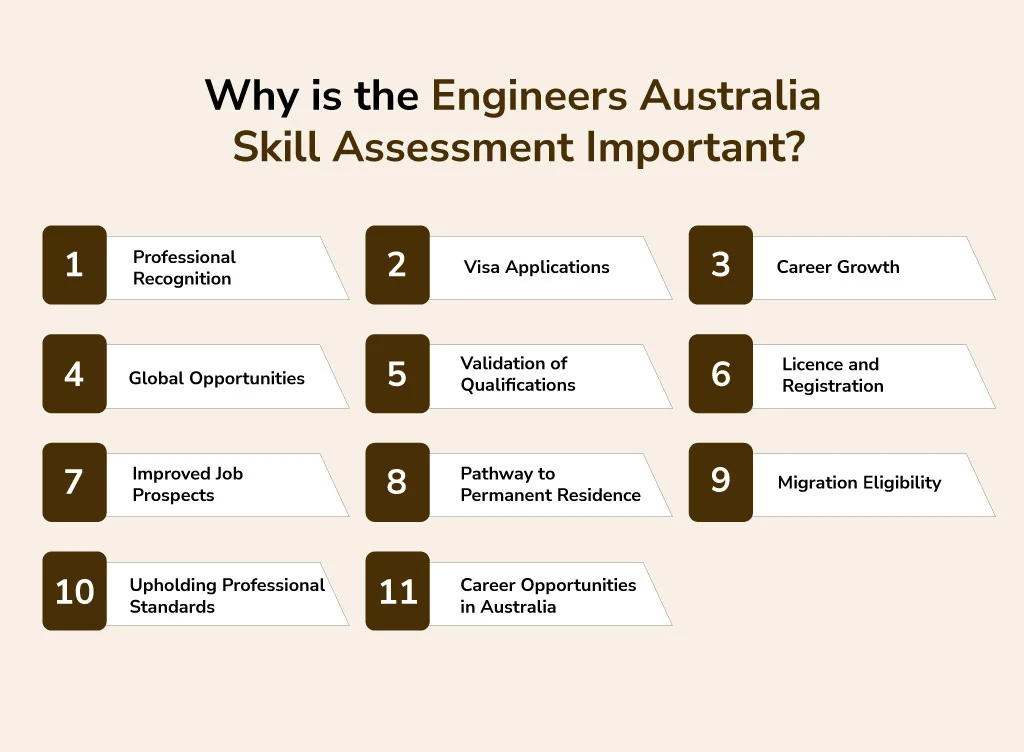
The Engineering Australia Skill Assessment plays a pivotal role for engineers wishing to build a professional career in Australia. It not only verifies your academic qualifications but also evaluates your engineering competencies and work experience against Australian standards.
Key reasons why EA Skill Assessment is essential:
1. Professional Recognition
The EA Skill Assessment is a key step towards gaining professional recognition in Australia. It thoroughly evaluates your qualifications and work experience to ensure they align with the standards set by Engineers Australia.
Successfully passing this assessment grants you formal recognition as an engineer in the country, which is highly respected by employers.
This recognition not only validates your expertise but also shows your dedication to meeting the high standards expected in Australia’s engineering industry.
2. Visa Applications
For engineers looking to migrate to Australia, the EA Skill Assessment is often a mandatory requirement, especially for skilled migration visas in engineering-related fields. A positive assessment is crucial, as it significantly boosts your chances of visa approval.
Without it, your visa application may not succeed. This makes it essential to carefully review and understand the Engineers Australia Skill Assessment document checklist to ensure all requirements are met.
3. Career Growth
A successful EA skill assessment opens up a wide range of career opportunities. It signals to employers that you have the skills and knowledge needed to excel in your field, which can lead to better job prospects, higher salaries, and long-term career advancement.
Employers in Australia tend to favour candidates who have undergone this assessment, as it assures them of their qualifications and reduces the need for additional evaluations.
4. Global Opportunities
The EA Skill Assessment is recognised internationally, allowing engineers to explore job opportunities in countries that have mutual recognition agreements with Australia.
This globalisation enhances your career mobility and broadens your professional horizons, making it easier to work in different parts of the world.
5. Validation of Qualifications
The assessment serves as a formal validation of your academic qualifications and professional experience. It confirms that your skills, even if acquired overseas, meet the standards required to work in Australia’s engineering sector.
6. Licence and Registration
In certain engineering disciplines, particularly those involving public safety, you may need to obtain a license or registration to practice.
A positive EA Skill Assessment often plays a key role in this process, as it demonstrates that your qualifications meet the necessary criteria for licencing.
7. Improved Job Prospects
Completing the EA Skill Assessment makes you a more attractive candidate to employers in Australia’s engineering industry.
It reflects your commitment to maintaining professional standards and gives employers confidence in your abilities. This can lead to better job opportunities and increased earning potential.
8. Pathway to Permanent Residence
For many engineers, the EA Skill Assessment is a critical step towards achieving permanent residency in Australia.
A positive outcome can significantly enhance your chances of securing a skilled migration visa and earning valuable points in the Permanent Residence Points System.
9. Migration Eligibility
The EA Skill Assessment is a mandatory requirement for engineers applying for migration through the General Skilled Migration (GSM) programme.
It ensures that your qualifications and experience meet the standards expected in Australia, making you eligible for skilled migration.
10. Upholding Professional Standards
The EA Skill Assessment plays a vital role in maintaining the high quality of engineering practice in Australia.
Ensuring that only qualified professionals are recognised helps protect public safety and ensures that engineering projects are carried out by competent individuals.
11. Career Opportunities in Australia
With a successful EA Skill Assessment, you gain access to Australia’s dynamic engineering sector, which offers numerous opportunities for growth and development.
Whether you’re looking to start your career or take it to the next level, this assessment can be a game-changer in achieving your professional goals.
Why You Should Choose CDR Genius?
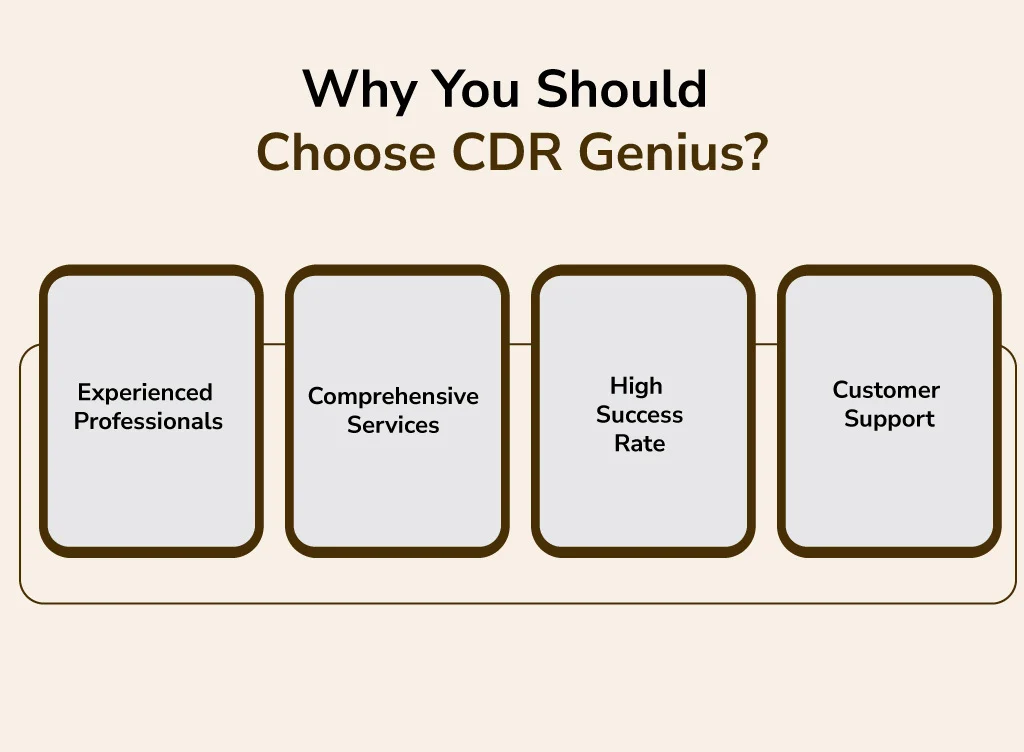
1. Experienced Professionals
Having worked with countless engineers to achieve a positive EA Skill Assessment, CDR Genius’s board of skilled professionals can help you too. Their mastery in the field, along with their creative process and knowledge, puts your application in good hands.
2. Comprehensive Services
CDR Genius covers every aspect of the EA Skill Assessment with their CDR writing, career episode preparation, and document composition services, ensuring a successful journey from initial consultation to final submission at an EA Assessment.
3. High Success Rate
Numerous clients are provided with a positive CDR assessment due to the amazing success rate CDR Genius has. This achievement is a result of their focus and determination to provide the best quality services.
4. Customer Support
An additional benefit to CDR Genius is the excellent customer support services. There is always someone available on the team to guide you and answer questions or concerns during any stage of the process.
Learn more: 💯💥 Write a compelling CDR report for Australian Skilled Migration. ✅✔️
Guidance in Simple Steps for EA Skill Assessment
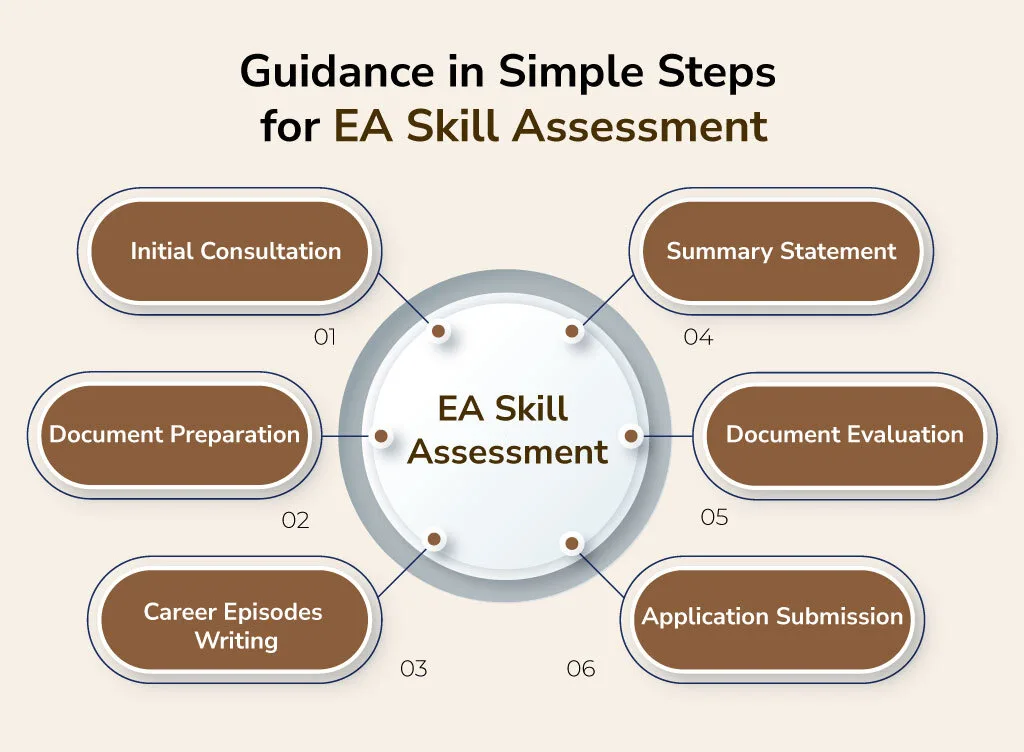
1. Initial Consultation
The first step is to book an initial meeting with a CDR professional. This meeting will be devoted to discussing your experience, education, and professional aspirations.
The professional will summarise your EA Skill Assessment options and mention what has to be done.
2. Document Preparation
The next step is to collect and arrange the necessary documents for your application. This document list includes academic qualifications, employment references, and other relevant documentation.
A CDR expert can assist you in ensuring that all documents are organised, properly prepared, and meet the requirements of Engineers Australia.
3. Career Episodes Writing
One critical part of the EA Skill Assessment is the Career Episode Report. This report describes your engineering experience and includes your competencies.
A CDR expert can assist you on how to write effective career episodes that highlight your skills and career accomplishments.
4. Summary Statement
Your CDR is incomplete without the summary statement. The summary statement contains a summary of one’s abilities and competencies based on career episodes.
A CDR professional can assist you in coming up with a well-written summary statement that concerns the competencies set out by Engineers Australia.
5. Document Evaluation
Having a CDR specialist examine your application for errors or omissions before submission is non-negotiable. It is a requirement for meeting the set standards by Engineers Australia.
6. Application Submission
The last step is to submit your application after filing everything and putting it in its final form. Make sure to follow the guidelines and visit the provided website beforehand. A CDR expert can help you submit your application right on time.
Occupational Categories
Engineers Australia recognises four occupational categories for skilled migration:
- Professional Engineer
- Engineering technologist
- Engineering associate
- Engineering manager.
Based on your qualifications and skills, you would be assigned to work in one of these occupational categories in Australia.
Assessment Pathways
1. Australian Qualification
Australian qualifications are recognised under the Australian Qualifications Framework (AQF), ensuring national standards for education and training. They range from Certificate I to Doctoral Degrees and are highly valued for employment and migration purposes.
2. Dublin Accord
The Dublin Accord focuses on the recognition of engineering technician qualifications.
- It is for engineering technicians, typically with diploma-level qualifications.
- It ensures that qualifications meet global standards for technician-level professionals.
3. Washington Accord Pathway
The Washington Accord is an international agreement that recognises engineering qualifications from signatory countries. If you have qualifications from a Washington Accord signatory country, you may be eligible for this pathway.
4. Sydney Accord Pathway
The Sydney Accord is similar to the Washington Accord but applies to engineering technologists. If you have qualifications from a Sydney Accord signatory country, you may be eligible for this pathway.
Creating a Career Episode Report
1. Introduction
The introduction provides an overview of the project or role you are describing. It should include the context, your position, and the duration of the project or role.
2. Background
The background section provides detailed information about the project or role. It should include the objectives, scope, and any challenges you faced.
3. Personal Engineering Activity
This section is the most critical part of your career episode. It should describe your specific contributions to the project or role, including the tasks you performed, the methods you used, and the outcomes you achieved.
4. Summary
The summary statement provides a brief overview of the career episode, highlighting your key achievements and the competencies you demonstrated.
Tips for Writing an Effective Career Episode Report:
- Be Specific: Focus on individual contributions and responsibilities.
- Use Technical Language: Highlight your engineering skills with technical details.
- Follow EA Guidelines: Ensure each episode is 1,000–2,500 words and written in first-person format.
- Avoid Plagiarism: Originality is key. Do not copy content from online sources.
Summary Statement Based On Career Episode Report (CERs)
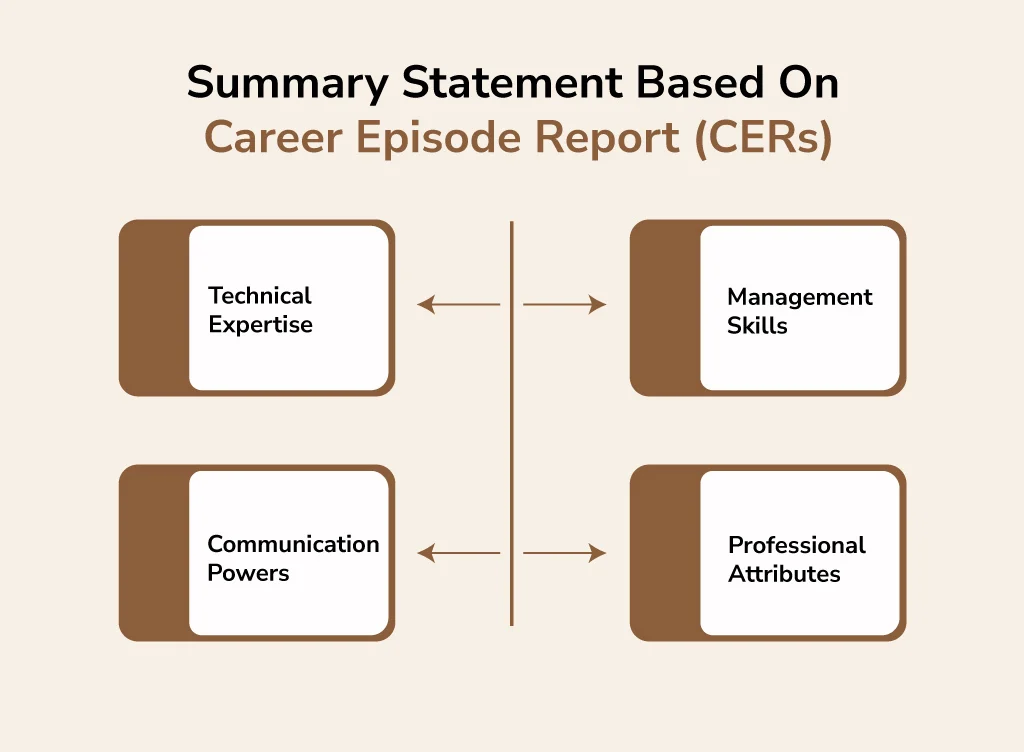
Your Career Episode Reports (CERs) need to showcase a range of skills and abilities across four key areas:
1. Technical Expertise
Demonstrate your grasp of engineering fundamentals, how you put them into practice, and your capacity to solve problems.
2. Management Skills
Highlight your ability to plan, organise, and oversee projects, as well as any leadership qualities you’ve displayed.
3. Communication Powers
Engineers must be effective communicators. Your CERs should prove your capacity to communicate clearly and effectively with colleagues, clients, and other involved parties.
4. Professional Attributes
Showcase your commitment to ethical conduct, your ability to collaborate effectively within a team, and your dedication to ongoing learning and professional development.
How to Write a Strong Summary Statement:
- Use a Table Format: Map each competency element to the relevant section in your career episodes.
- Be concise: Avoid lengthy explanations; focus on demonstrating competency.
- Proofread: Ensure your summary statement is error-free and aligns with Engineers Australia’s guidelines.
Conclusion
The Engineers Australia Skill Assessment is a vital process for engineers aiming to work and live in Australia. By understanding the assessment process, preparing a high-quality CDR, and seeking professional guidance, you can significantly improve your chances of success.
At CDR Australia Group, we are committed to helping you every step of the way. From creating exceptional CDR reports to offering personalised advice, we ensure that your journey towards a successful skill assessment is smooth and stress-free.
The Engineers Australia (EA) Skill Assessment is a crucial step for engineers aiming for professional recognition, career growth, and migration to Australia. Recognizing its significance, seeking expert guidance, and adhering to the right approach can significantly improve your chances of success.
At CDR Genius, we provide expert assistance and comprehensive services to help you secure a positive assessment. With a strong track record of success, we are here to support you at every stage of the process. Don’t wait—take the first step towards a rewarding engineering career in Australia today!
FAQs
1. How long does skills assessment take engineers in Australia?
The processing time for an Engineers Australia Skill Assessment typically takes 12 to 16 weeks from the date of submission. However, this timeframe can vary depending on the complexity of your application, the pathway you choose, and the volume of applications being processed by Engineers Australia.
To avoid delays, ensure that all required documents are submitted correctly and meet the guidelines.
2. What is the success rate of Engineers Australia’s skill assessment?
The success rate of the Engineers Australia Skill Assessment depends on the quality of the application and adherence to the guidelines.
While Engineers Australia does not publish official success rates, applicants who submit well-prepared Competency Demonstration Reports (CDRs), provide accurate documentation and demonstrate their engineering competencies effectively have a high chance of success.
Seeking professional guidance from CDR experts can significantly improve your chances of approval.
3. How much PTE score is required for Australia for engineers?
Engineers applying for migration or professional recognition in Australia must demonstrate English language proficiency. The required PTE (Pearson Test of English) scores are:
- Competent English: Minimum PTE score of 50 in each module (Listening, Reading, Writing, and Speaking).
- Proficient English: Minimum PTE score of 65 in each module.
These scores are aligned with the Department of Home Affairs’ requirements for skilled migration visas.
4. How much does skill assessment cost?
The cost of the Engineers Australia Skill Assessment is AUD 1,172 for a standard application. Additional fees may apply for fast-track processing, reassessment, or appeals. It’s important to budget for these costs and ensure that your application is complete to avoid unnecessary expenses.
5. What documents are needed for skill assessment in Australia?
The documents required for the Engineers Australia Skill Assessment include:
- Academic transcripts and degree certificates: certified copies of your engineering qualifications.
- English Language Test Results: PTE, IELTS, or TOEFL scores (if applicable).
- Employment References: Detailed references from employers, including job titles, responsibilities, and duration of employment.
- Curriculum Vitae (CV): A comprehensive CV outlining your education and work experience.
- Competency Demonstration Report (CDR): Includes three career episodes, a summary statement, and a Continuing Professional Development (CPD) report.
- Passport Copy: A certified copy of your passport bio-data page.
Ensure all documents are certified and meet Engineers Australia’s guidelines to avoid delays or rejection.
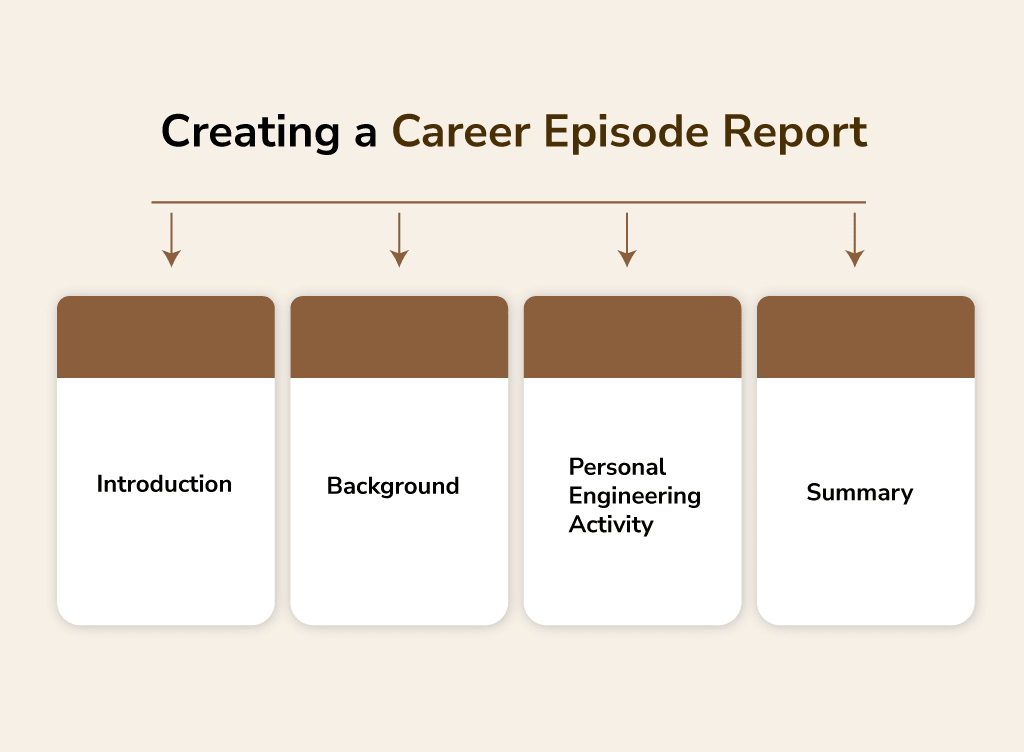
 Chat with us
Chat with us